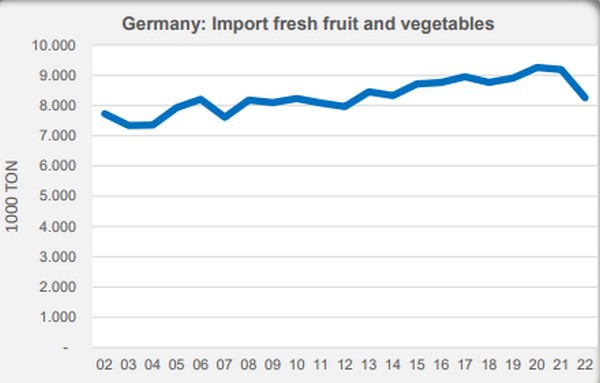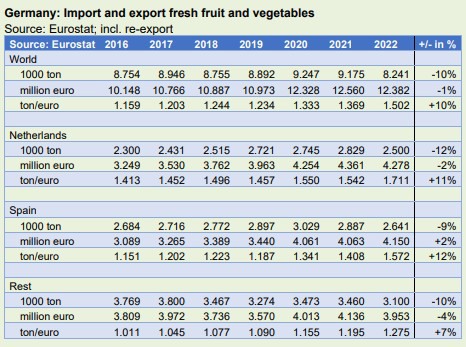As was evident throughout the year, German imports of fresh fruit and vegetables fell sharply in 2022. Over the whole year, imports ended up at 8.2 million tonnes. That was 10% less than in both previous years. German imports were also smaller than in previous years. We need to go back to around 2010 to see imports on the level as in 2022. Because fruit and vegetables in 2022 were, on average, priced much higher than in previous years, imports by value in 2022 remained at almost the same level as in 2021, at €12.4 billion.

Particularly less from Spain and the Netherlands
In particular, there were significantly less fruit and vegetables imported from the two major suppliers, Spain and the Netherlands, in 2022 than before. For the Netherlands, this mainly applied to produce grown in the Netherlands. Re-exports via the Netherlands were slightly less bad. Imports from other larger suppliers also lagged behind in 2022. However, there was growth in imports from South Africa, Morocco, and Peru. Double minus figures were recorded for all major imports. Imports of tomatoes actually fell by 16%, cucumbers by 13%, apples by 14%, and bananas and oranges by 10%. Imports of peppers performed slightly less bad, with a minus of 8%. Of the larger products, only grapes and peaches showed a plus.
Far fewer greenhouse vegetables
Germany's imports of Dutch tomatoes fell by a quarter to less than 300,000 tonnes by 2022. For these amounts, we have to go back almost 20 years. Imports of Dutch cucumbers fell by over 10% to 212,000 tonnes. German imports of Dutch peppers were 'only' 8% smaller, reaching 122,000 tonnes.

Far fewer of the big three greenhouse vegetables were imported, not only from the Netherlands. The same goes for imports from Spain, although, of course, the seasons differ. Imports of these products from other countries are many times smaller. However, it is notable that imports of Moroccan tomatoes are rising very fast, to 70,000 tonnes in 2022 from only 40,000 tonnes in 2019. For cucumbers, imports from other countries do not represent much. For peppers, although imports from Morocco are also increasing rapidly, they remained at 35,000 tonnes in 2022. In apples, the big suppliers Italy and Poland had to make a big gain in 2022. More apples were imported from the Netherlands and Belgium, though. Of all oranges imported into Germany, 80% came from Spain. Its imports fell 7% to a level lower than many years before.
Fewer and fewer apples and oranges
Taking a longer-term view, there are a number of 'old-fashioned' products whose imports are much lower today. German apple imports were still at over 800,000 tonnes in 2002/06. In 2022, it was still 530,000 tonnes, and in 2021 over 600,00o tonnes. Imports of oranges were still just under 6000,00 in 2002/06. In 2021, it was 485,000 tonnes, and only 435,000 tonnes last year. German imports of pears and grapes declined, but in recent years there has been some growth again. More strikingly, German imports of kiwis peaked in the years 2007/11 before gradually declining.
Click here for background figures.
For more information:
Jan Kees Boon
Fruit and Vegetable Facts
fruitvegfacts@gmail.com
www.fruitandvegetablefacts.com
